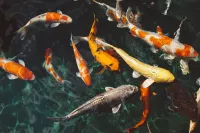Historical perspective: Fish consumption in ancient civilizations
Fish has been a significant part of human diets for thousands of years. In ancient civilizations, such as Egypt and Mesopotamia, fish were not only a source of sustenance but also held symbolic and religious significance. The abundant supply of fish from rivers and oceans played a crucial role in the growth and development of these civilizations. Fish were often preserved through methods like drying or smoking, allowing them to be consumed even during times of scarcity. The consumption of fish was particularly important in coastal regions, where fishing became a way of life for many communities.
As societies evolved, fish consumption continued to be a vital part of diets, with fishing methods becoming more advanced. In medieval Europe, fish was a staple food during religious observances, and fish markets thrived in coastal towns. The discovery of new fishing grounds during the age of exploration further expanded the availability of fish, leading to increased consumption across continents. However, it wasn't until the industrial revolution that fish consumption truly began to change, with the advent of new technologies enabling mass fishing and distribution.
The rise of meat consumption: From hunting to domestication
While fish consumption has a long history, the consumption of meat has its own fascinating story. In the early days of human existence, hunting was the primary means of obtaining meat. Our ancestors relied on their hunting skills to secure animal protein, which was crucial for survival. As humans developed tools and weapons, hunting became more efficient, allowing for larger game to be captured. The domestication of animals marked a significant turning point in meat consumption, as it provided a more sustainable and controlled source of meat.
The domestication of animals began around 10,000 years ago, and it revolutionized human diets. With the ability to raise and breed animals for meat, societies no longer relied solely on hunting. This shift allowed for a more stable food supply and paved the way for the development of agriculture and civilization as we know it. Domesticated animals, such as cattle, sheep, and pigs, became integral to human diets, providing not only meat but also other valuable resources like milk, wool, and leather.
Environmental impact: The consequences of increased fish and meat consumption
As fish and meat consumption increased with the growth of human populations, so did the environmental impact. Overfishing has become a pressing issue, with many fish populations being depleted or on the brink of collapse. Destructive fishing practices, such as bottom trawling, have also resulted in widespread damage to marine ecosystems. Additionally, the production of meat, particularly beef, has been linked to deforestation, greenhouse gas emissions, and water pollution.
These environmental consequences have raised concerns about the sustainability of our current consumption patterns. As we continue to deplete natural resources and degrade ecosystems, it becomes increasingly important to find alternative sources of protein that can meet the nutritional needs of a growing population without further harming the planet.
Health implications: The benefits and risks of consuming fish and meat
Fish and meat have long been recognized as valuable sources of protein, essential nutrients, and omega-3 fatty acids. Fish, in particular, is known for its high levels of omega-3s, which have been shown to have numerous health benefits, including reducing the risk of heart disease. However, concerns have also been raised about the potential risks associated with consuming certain types of fish due to contamination with mercury and other pollutants.
Meat, on the other hand, provides important nutrients like iron, vitamin B12, and zinc. However, excessive consumption of red and processed meats has been linked to an increased risk of chronic diseases, including cardiovascular disease and certain types of cancer. Balancing the benefits and risks of consuming fish and meat is crucial for maintaining a healthy diet.
Modern diets: The shift towards plant-based alternatives
In recent years, there has been a noticeable shift in dietary preferences towards plant-based alternatives. This trend can be attributed to a variety of factors, including concerns about health, animal welfare, and the environment. Many individuals are adopting vegetarian or vegan diets, completely eliminating fish and meat from their meals. Others are opting for flexitarian or pescatarian diets, which allow for limited consumption of fish and meat.
Plant-based alternatives to fish and meat have gained popularity, with innovations in food technology leading to the creation of realistic and tasty substitutes. These alternatives range from plant-based burgers and sausages to seafood made from algae or other plant sources. With advancements in taste and texture, these alternatives offer a compelling choice for those looking to reduce their consumption of fish and meat without compromising on flavor or nutritional value.
Sustainable seafood and ethical meat: Making conscious choices
Despite the shift towards plant-based alternatives, many individuals still choose to include fish and meat in their diets. For those who do, there is a growing emphasis on making sustainable and ethical choices. Sustainable seafood initiatives aim to promote responsible fishing practices, protect marine ecosystems, and ensure the long-term viability of fish stocks. Certifications such as the Marine Stewardship Council (MSC) and Aquaculture Stewardship Council (ASC) provide consumers with a way to identify seafood that has been sourced sustainably.
Similarly, ethical meat production focuses on animal welfare and minimizing the environmental impact of livestock farming. Organic and pasture-raised meat options offer alternatives to conventional factory farming practices, providing consumers with a choice that aligns with their values. By supporting sustainable seafood and ethical meat, individuals can contribute to positive change within the food industry.
Cultural and social factors: The role of fish and meat in different societies
The consumption of fish and meat is not only influenced by nutritional and environmental factors but also by cultural and social norms. In many societies, certain fish and meat dishes play a central role in traditional cuisines and cultural celebrations. These dishes often reflect the local environment and historical traditions, passing down recipes and culinary techniques through generations.
The significance of fish and meat in different societies can also be seen in the symbolism attached to certain foods. For example, fish is associated with fertility and abundance in some cultures, while meat is often linked to status, power, and hospitality. These cultural and social factors shape our dietary choices and contribute to the diversity of global food cultures.
Future trends: Predictions for the future of fish and meat consumption
Looking ahead, the future of fish and meat consumption is likely to be shaped by a variety of factors. As concerns about the environmental impact of fishing and meat production continue to grow, it is expected that alternative sources of protein will become increasingly popular. Plant-based alternatives will likely continue to improve in taste and accessibility, appealing to a broader range of consumers.
Advancements in technology, such as lab-grown meat and cellular agriculture, may also play a role in the future of food. These innovations have the potential to provide sustainable and ethical alternatives to conventional fish and meat production. However, their widespread adoption and acceptance may depend on factors such as cost, taste, and consumer attitudes towards these novel food options.
Conclusion: Striking a balance between tradition, health, and sustainability
As our understanding of the impacts of fish and meat consumption evolves, so too must our dietary choices. Striking a balance between tradition, health, and sustainability is key to navigating the complex landscape of modern diets. Whether we choose to reduce our consumption of fish and meat, opt for sustainable and ethical alternatives, or embrace new innovations in food technology, our choices have the power to shape the future of our diets and the world we inhabit. By being conscious consumers and making informed decisions, we can contribute to a more sustainable and compassionate food system for generations to come.
---
*Note: The content of this blog article is for informational purposes only and should not be considered as medical or dietary advice. Please consult with a healthcare professional or nutritionist before making any significant changes to your diet.*

 Different Types of Fish and Their Unique Characteristics
Different Types of Fish and Their Unique Characteristics Exploring the World of Meat Delicious Recipes
Exploring the World of Meat Delicious Recipes



